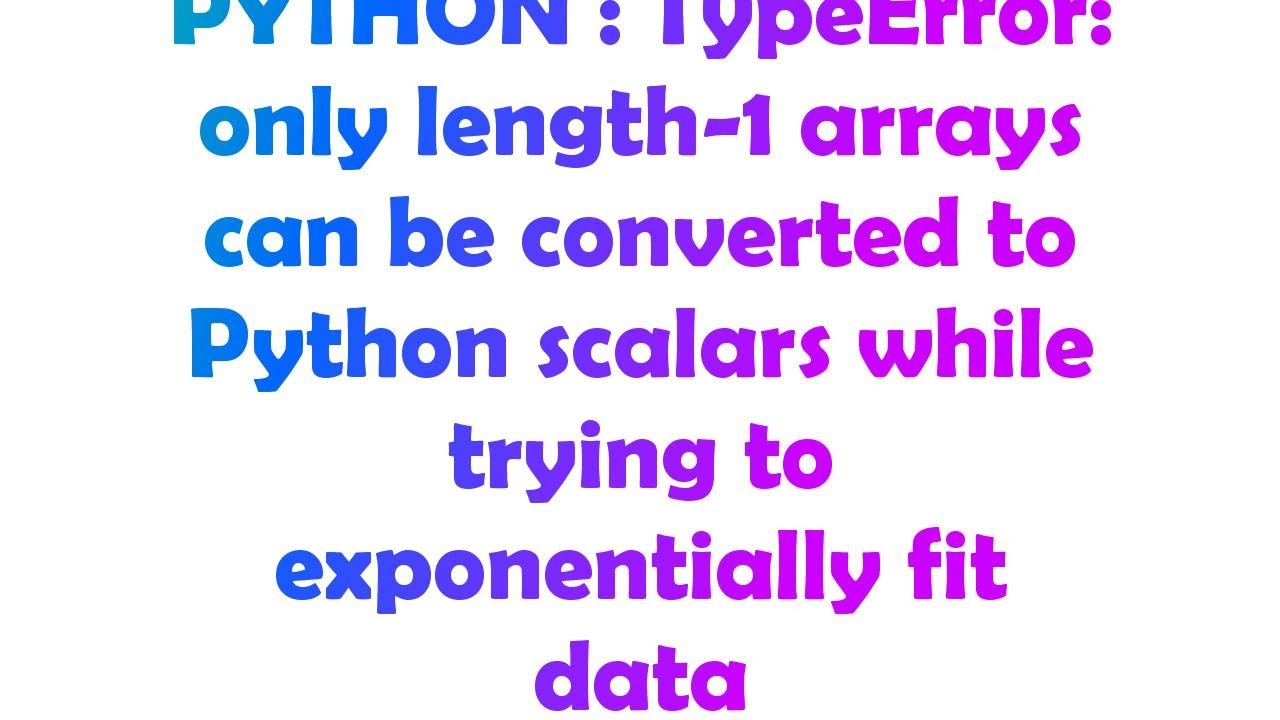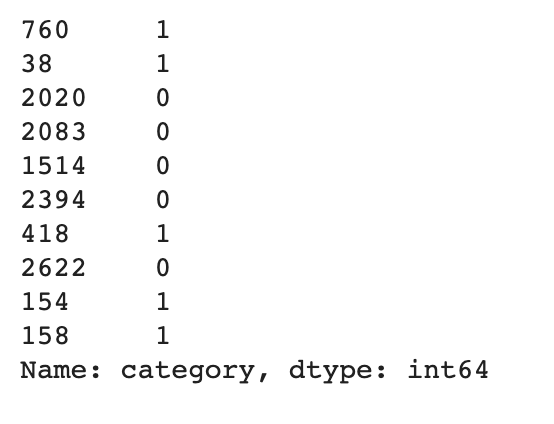Unraveling Python: Scalar Conversion with Length1 Arrays

In the world of programming, especially when working with dynamic and versatile languages like Python, it is essential to understand the intricacies of data manipulation. One such concept that often poses challenges, especially for newcomers, is the conversion of scalar values to arrays, particularly when dealing with length1 arrays, which are arrays with a single element. This process, although seemingly straightforward, involves a series of considerations and best practices to ensure efficient and accurate data handling. This article aims to delve into the nuances of scalar conversion with length1 arrays, exploring the various methods, potential pitfalls, and optimal approaches to master this fundamental aspect of Python programming.
Understanding Scalar Conversion

Scalar conversion in Python refers to the process of transforming a single value, or a scalar, into an array format. This is a common operation when working with data structures, as it allows for consistent handling and processing of data, regardless of its original form. For instance, consider a scenario where you have a list of temperatures, and you need to perform calculations or apply functions that expect arrays as input. In such cases, scalar conversion becomes crucial to ensure uniformity in your data representation.
When it comes to scalar conversion, Python offers a range of built-in functions and methods that can be utilized. However, the choice of method depends on the specific requirements of your task, as well as the nature of the scalar value you are dealing with. In the context of length1 arrays, where we have a single element that needs to be converted, the process becomes slightly more nuanced, requiring careful consideration of the desired output format and potential implications.
Methods for Scalar to Length1 Array Conversion

There are several approaches to convert a scalar value into a length1 array in Python. Each method has its own advantages and considerations, making the choice dependent on the specific context and requirements of your programming task. Let’s explore some of the most commonly used methods:
Method 1: Using the list() Function
One straightforward way to convert a scalar value into a length1 array is by using the list() function. This function takes an iterable as input and returns a new list containing the elements of the iterable. When applied to a scalar, it wraps the value in a list, effectively creating a length1 array. For instance:
scalar_value = 42 length1_array = list(scalar_value) print(length1_array) # Output: [42]
This method is simple and intuitive, making it a popular choice for beginners. However, it's essential to note that the list() function may not always be the most efficient or appropriate for all scenarios, especially when dealing with complex data types or performance-critical tasks.
Method 2: Utilization of the array.array() Function
Python’s array module provides a more specialized function, array.array(), which is designed for creating arrays of a specific data type. This function allows you to specify the type of elements you want in your array, ensuring consistent and type-safe data handling. To convert a scalar value into a length1 array using this function, you can follow this pattern:
import array
scalar_value = 42
length1_array = array.array('i', [scalar_value])
print(length1_array) # Output: array('i', [42])
In this example, 'i' represents the integer data type, ensuring that the scalar value is properly converted and stored as an integer within the array. The array.array() function provides an efficient and type-safe approach to scalar conversion, especially when working with large datasets or performance-critical applications.
Method 3: Leveraging numpy for Array Creation
For tasks involving scientific computing or data manipulation, the numpy library is a powerful tool. Numpy provides a wide range of functions and data structures for efficient numerical operations. When it comes to scalar conversion, the numpy.array() function is a versatile and high-performance option. Here’s how you can use it to create a length1 array from a scalar value:
import numpy as np scalar_value = 42 length1_array = np.array(scalar_value) print(length1_array) # Output: array([42])
The numpy.array() function automatically infers the data type of the scalar value and creates an array with that specific data type. This makes it a convenient and flexible choice for many data manipulation tasks. Additionally, numpy arrays offer optimized memory usage and efficient mathematical operations, making them a popular choice in scientific and numerical computing domains.
Method 4: Pandas Series for Scalar to Array Conversion
In the realm of data analysis and manipulation, the pandas library is an invaluable tool. Pandas provides a Series data structure, which is essentially a one-dimensional labeled array capable of holding data of any type. Converting a scalar value into a length1 Series is a straightforward process using the pandas.Series() function:
import pandas as pd scalar_value = 42 length1_series = pd.Series(scalar_value) print(length1_series) # Output: 0 42 dtype: int64
The resulting Series object provides a flexible and labeled array representation of the scalar value, allowing for easy integration with other pandas data structures and functions. Pandas Series are particularly useful when working with tabular data and performing data analysis tasks.
Performance and Considerations
When choosing a method for scalar to length1 array conversion, it’s crucial to consider the performance implications and the specific requirements of your task. Each method has its own strengths and weaknesses, and the optimal choice depends on factors such as data type, memory usage, and computational efficiency. For instance, while the list() function is simple and intuitive, it may not be the most efficient choice for large-scale data processing. On the other hand, the array.array() function offers type-safety and efficiency, making it suitable for performance-critical applications.
Additionally, the choice of method may also depend on the ecosystem of libraries and tools you are working with. For instance, if you are heavily invested in the numpy ecosystem for numerical computing, utilizing the numpy.array() function for scalar conversion may be the most seamless and efficient approach. Similarly, if your task involves data analysis and manipulation with pandas, the pandas.Series() function provides a natural and convenient way to work with scalar values.
Real-World Examples and Use Cases
Scalar conversion with length1 arrays finds applications in a wide range of real-world scenarios. Here are a few examples to illustrate the practical implications of this concept:
Example 1: Data Normalization
In data preprocessing tasks, it is common to normalize data to a specific range. For instance, when working with machine learning algorithms, normalizing input features to a standard scale (e.g., mean = 0, standard deviation = 1) can improve model performance and convergence. Scalar conversion is often used in this context to ensure that scalar values, such as mean or standard deviation, are represented as arrays, allowing for consistent and uniform data manipulation.
Example 2: Image Processing
In image processing tasks, scalar values often represent single-pixel intensities or color values. When working with image data, it is crucial to maintain a consistent data structure, ensuring that scalar values are properly converted into arrays for efficient processing. This is particularly important when applying filters, performing transformations, or applying machine learning algorithms to image data.
Example 3: Financial Analysis
In financial analysis and time series data manipulation, scalar values often represent key indicators such as stock prices, interest rates, or economic indicators. Converting these scalar values into arrays allows for consistent and standardized data handling, making it easier to apply various analysis techniques, such as moving averages, exponential smoothing, or technical indicators.
Future Implications and Best Practices

As Python continues to evolve and new libraries and tools emerge, the landscape of scalar conversion and data manipulation is likely to expand and diversify. Here are a few future implications and best practices to consider:
- Exploring New Libraries: Keep an eye on emerging libraries and tools that specialize in data manipulation and processing. Libraries like dask, xarray, or torch offer advanced data structures and functions that may provide more efficient or specialized approaches to scalar conversion and array handling.
- Performance Optimization: As data sizes continue to grow, performance optimization becomes increasingly important. Consider profiling your code and optimizing scalar conversion operations to ensure efficient and scalable data handling, especially in large-scale applications.
- Consistency and Standardization: Establish consistent practices and conventions for scalar conversion within your team or organization. This ensures that data is handled uniformly across different tasks and projects, reducing potential errors and facilitating collaboration.
By staying updated with the latest advancements and adopting best practices, you can ensure that your scalar conversion operations remain efficient, reliable, and adaptable to the evolving needs of data manipulation and analysis in Python.
Can I use the tuple() function for scalar to length1 array conversion?
+
While the tuple() function can be used to convert a scalar value into a length1 tuple, it is generally not recommended for array creation. Tuples are immutable, meaning their elements cannot be modified once created. This limits the flexibility and utility of tuples in data manipulation tasks. It is best to use functions specifically designed for array creation, such as list(), array.array(), numpy.array(), or pandas.Series(), depending on the context and requirements of your task.
Is there a way to automatically infer the data type when converting a scalar to an array in Python?
+Yes, libraries like numpy and pandas offer functions that automatically infer the data type of the scalar value and create arrays accordingly. For instance, the numpy.array() function and the pandas.Series() function both infer the data type and create arrays with the appropriate type. This ensures type-safety and consistency in your data manipulation tasks.
What are some common pitfalls to avoid when converting scalars to length1 arrays in Python?
+Some common pitfalls to avoid include:
- Choosing an inappropriate method for your specific task, leading to inefficient or incorrect data handling.
- Forgetting to consider the data type of the scalar value and its implications on array creation.
- Neglecting performance considerations, especially when dealing with large datasets or performance-critical applications.
- Failing to establish consistent practices for scalar conversion within your team or organization, leading to potential errors and inconsistencies.


